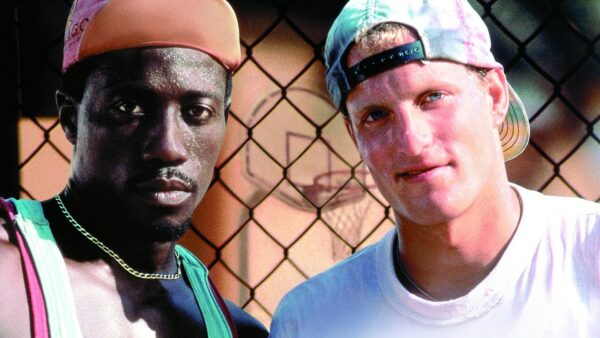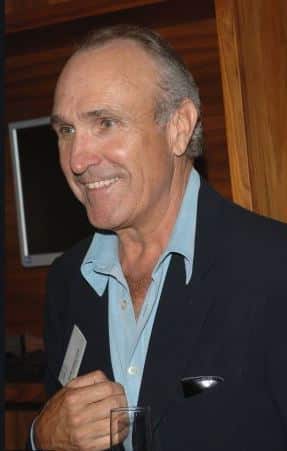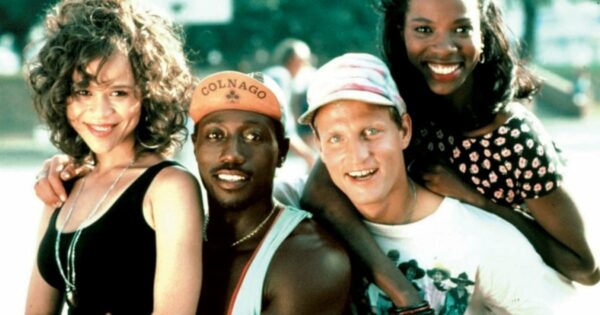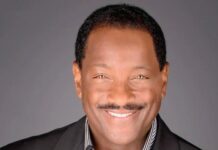
*It may be a film with universal appeal, but “White Men Can’t Jump,” in its essence, is simply an earth-bound “L.A. story” seasoned heavily with streetballer appeal.
That mix proved potent in more ways than one, decades later, as the ’90s sports classic remains in the hearts of movie fans who first saw it in theaters and keep its classic scenes, lines and characters in their hearts via home video back in the day (#VHS) and YouTube and any streaming service that carries it online.
Echoing their affection, Tyra Ferrell, one of the stars of “White Men Can’t Jump,” brings a personal angle to the fold, with a word to reinforce the love when remembering the film that marked a true career highlight.
“Accomplished, as an actor,” Ferrell, who played Rhonda Deane, the wife of Wesley Snipes’ Sidney Deane, told EURweb. “It makes me feel like I accomplished what I set out to do when I decided to be an actor and that was to be part of the best.”
With Snipes, Ferrell was in good company. We’re talkin’ company that included fellow all-stars Woody Harrelson and Rosie Perez, along with “White Men Can’t Jump” writer and director Ron Shelton. Shelton, coming off the success of his 1988 feature, “Bull Durham,” leaned into his past as a streetballer when thinking of his follow up to the 1988 Kevin Costner, Susan Sarandon-starring romantic comedy. The filmmaker admits his next project was fueled by bringing two of his favorite loves (Los Angeles, CA and street basketball) to the forefront in a great way.
MORE NEWS ON EURWEB: Oscars Producer Will Packer Guarantees You Won’t be Bored with Tonight’s Show | WATCH

“I wanted to make an “L.A.” story and I wanted to make a story about street basketball, which I played (I played basketball and baseball in high school and college). And when I realized that these two ideas were part of the same story, I started writing it,” Shelton shared with EURweb when tracing his path to making what ultimately became “White Men Can’t Jump.”
A ‘Bulli’ish Influence and Black-on-Black Love
Shelton’s involvement behind the camera was reason enough for Ferrell to join the cast, which also included Kadeem Hardison, Cylk Cozart, Duane Martin and the late actor/comedian Reynaldo Rey. The “Poetic Justice” entertainer cited Sarandon’s performance in “Bull Durham” for the additional motivation to work with the director.
“Truthfully, Ron Shelton,” Ferrell confessed. “I had seen ‘Bull Durham’ with Susan Sarandon. And I really liked the film, and I liked her character. She was well-written for me, and I could identify with Susan Sarandon’s acting as well as her performance. So, when I heard Ron Shelton was doing a movie called “White Men Can’t Jump,” I was excited about him, more so than anything.

“Then I heard that Wesley was attached to it. He was the hottest actor at the time. And so, he needed a girlfriend. Or he needed a wife,” Ferrell continued, while relishing the chance to bring an element rarely seen at the time in movies. “I wanted to show black-on-black love in the movie theaters and on the screen that I hadn’t seen before. And Wesley was a handsome dark-skinned brother and we had just done [the Spike Lee interracial romantic drama] “Jungle Fever” or “Jungle Fever” was out, and I knew that he needed to have a dark-skinned sister, who looked black as opposed to what he had in “Jungle Fever” as a wife. So that was my goal, to represent in that way. And I just wanted to work with Wesley and Ron Shelton.”
Mentioning Harrelson’s popularity on NBC’s Emmy-winning ‘80s sitcom “Cheers,” Ferrell noted how he and Perez added to the atmosphere she wanted to be around on “White Men Can’t Jump” and all acting endeavors.
“Woody was hot. And although I never watched, I did see some of the show. Woody Harrelson was a very hot actor at the time,” stated Ferrell. “And Rosie Perez as well. Everybody was at the top of their game. And I wanted to be a part of that. Like I said, I always wanted to be in the best. I always wanted to surround myself with actors to up my own game.”
Box Office Gold and Two Soundtracks
Shelton and Ferrell’s comments come amid the 30-year anniversary of “White Men Can’t Jump.” The film, released on March 27, 1992, starred Snipes and Harrelson as Sidney Deane and Billy Hoyle, two street ballers who ultimately team up to hustle other streetball players by getting them to pick Billy as Sidney’s partner.
Although competition came from sports-centered films “The Cutting Edge” and “Ladybugs, “White Men Can’t Jump,” took the top spot, pulling in $14,711,124 on its opening weekend. Total worldwide gross for the comedy came to $90,753,806.
In addition to a successful box office run, “White Men Can’t Jump” spawned two soundtracks as well as a video game based on the film and Nike shoes inspired by Billy Hoyle and Sydney Deane. The title track of the mostly R&B-laced first soundtrack featured the group Riff, with its music video highlighting clips from “White Men Can’t Jump” and appearances from Snipes, Harrelson and Perez, who played Billy’s “Jeopardy!” obsessed girlfriend, Gloria Clemente. The first soundtrack peaked at number 48 on Billboard’s Top R&B/Hip-Hop Albums chart and number 92 on the Billboard Hot 200, while the “White Men Can’t Jump” single ranked at number 90 on the Billboard Hot 100.
The second “White Men Can’t Jump” soundtrack, titled “White Men Can’t Rap,” provided a hip-hop flavor with rap artists dominating the album. Cypress Hill, Gang Starr and Boo-Yaa T.R.I.B.E. contributed to the EP, which contained the Main Source tune “Fakin’ the Funk,” that was used in the film. The second soundtrack charted at number 79 on Billboard’s Top R&B/Hip-Hop Albums chart.
A ‘Real’ Foundation
To create the street balling scenes in “White Men Can’t Jump, Shelton brought in real-life b-ballers in the form of former college and pro-basketball greats Marques Johnson, Gary Payton, Freeman Williams, Louis Price, Nigel Miguel and Duane Martin.
Johnson, a member of UCLA’s 1974-75 national championship team and several NBA teams, played Raymond, the streetballer who had no problem going to get his gun to avenge his loss to Sidney and Billy. Miguel, another UCLA standout and Martin, a former New York Knicks player turned actor, appear as rivals to Sidney and Billy in the final game of a local two-on-two basketball tournament.
Williams, who also played in the NBA and Price, a former member of The Temptations, was prominently featured as Eddie “The King” Faroo and Duck Johnson, two legendary street ballers who took on Sidney and Billy in the final high stakes game in the film.
Despite the inclusion of such notables, Shelton made a point of putting all potential on-screen players through intense basket tryouts before they auditioned for their respective roles.
“If you passed that test, you were in the movie,” he said. “The guys had to be real players.”
Basketball players weren’t the only real thing Shelton wanted for “White Men Can’t Jump.” A real look of his beloved Los Angeles was what the director wanted to add to look inside the world of street ballers, not the glamorous sites of the city that regularly get shown.
“I’m a native of Southern California and know that Los Angeles is an enormous, sprawling, complex place rich in diversity and full of neighborhoods that many people never see because we’re all stuck on the freeways,” said Shelton, who regarded L.A. as another character in “White Men Can’t Jump” with it’s prominent presence. “I wanted to show those neighborhoods, the L.A. where people actually live. Nobody lives at the ‘Hollywood Sign,’ but that’s what always gets filmed.”
For Los Angeles realness, look no further than Baldwin Village and the Vista View Apartments, where Sidney and Rhonda live. Knowing how tough the neighborhood is, Rhonda makes her desire for Sidney to move her to a better place to live and raise their son, memorably saying, “All I care about is getting out of the Vista View apartments because there ain’t no “vista,” there ain’t no “view,” and there certainly ain’t no vista of no view.” As a result, Sidney hustles on and off the basketball court to make ends meet and put his family into a better life.
The character’s struggle is proof he was motivated to leave Baldwin Village, whether Rhonda was around or not, according to Ferrell.
“Absolutely because he had dreams and aspirations,” she stated. “And the jobs he did have on the side were important business jobs. So of course, yeah. That’s what we wanted to show.”
Movie Legacy and Character Visions of the Future
As for why people still remember and enjoy “White Men Can’t Jump,” various reasons come to mind for Ferrell and Shelton.
“I think because it’s fun. It’s based in reality,” Ferrell said, adding “It’s the writing, great acting and the direction of the film. the cinematography. The slow-motion, the directing and editing made it brilliant.”
“Why has it lasted?” Shelton asked. “I think people like the characters, amidst all their flaws and struggles. And the characters (and actors) liked each other and that comes across.”
There’s no question. “White Men Can’t Jump” is a certified classic. Efforts are currently underway to remake the film, with “black-ish” creator Kenya Burris developing the project and NBA star Blake Griffin and NFL player Ryan Khalil on board as producers. In March, news broke that rapper Jack Harlow has been cast as Billy Hoyle in the remake, which was announced in 2017.

So, 30 years after “White Men Can’t Jump” set foot in theaters, the big question is what would Sydney, Gloria and Billy be up to in 2022? Did Sydney and Rhonda finally move out of the Vista View Apartments? In Ferrell’s eyes, the answer is a full-fledged “Yes.”
“They would absolutely still be together and yes, definitely, I believe they would have moved out of that neighborhood right after the movie,” she expressed while giving her take on where the Deane’s would be living their best lives today. “In terms of the neighborhood, I would like to say, maybe, knowing L.A. the way I do, I say Los Feliz. That’s a nice neighborhood, you know. It’s a lot of different cultures there. So, Los Feliz, maybe.”
As the writer and director of “White Men Can’t Jump,” Shelton sees a successful path taken by two of the three lead characters, with politics and entrepreneurship occupying space in the characters’ modern space.
“Sydney would be very successful, possibly a city councilman in L.A. with a fancy car and home, thinking of running for mayor and eyeing a run for bigger office,” Shelton detailed. “Gloria would be running a string of workout gyms, doing very well.
As for Billy, well….
“Billy, alas, still wouldn’t get it and would be a modest size fish in a very small pond,” according to Shelton.
We Publish News 24/7. Don’t Miss A Story. Click HERE to SUBSCRIBE to Our Newsletter Now!





